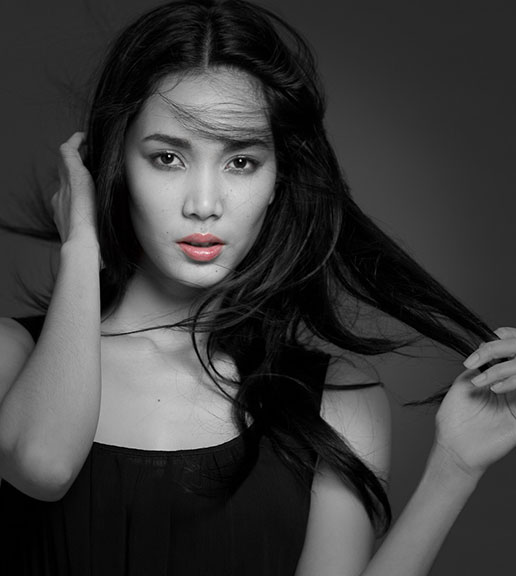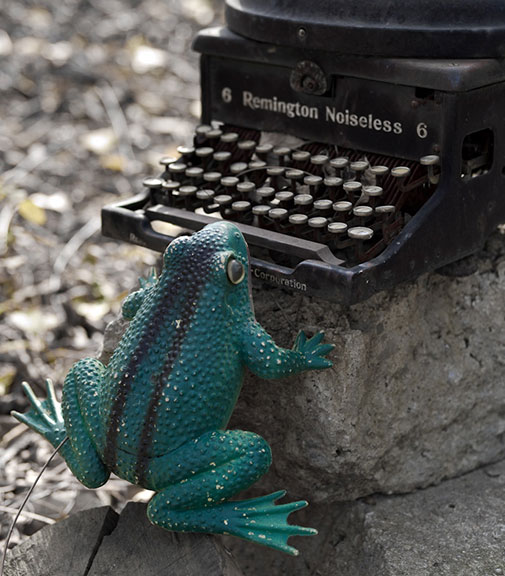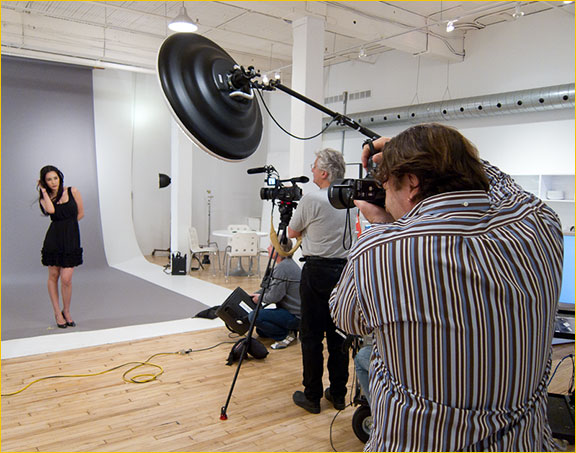
For three quarters of a century Leica has been a brand and company associated with the 35mm format. Now, with the S2 system, Leica breaks the mold and creates a new larger-than-35mm digital format as well as well as a completely new camera and lens system built around it. The S2 also is Leica’s first pro-level camera with autofocus, and also their first digital camera to be completely designed in-house.
In August, 2009, along with a small group of web journalists, I was invited to Leica’s headquarters in Solms, Germany to spend a few days shooting with apre-production S2as well as an M9. Then, in mid-November Leica sent me a production S2 along with 70mm f/2.5 and 180mm f/3.5 lenses. The body and lenses are final, but the firmware in my review camera (1.0.09) is still a work in progress, and won’t be finalized until the camera ships in January.
Some minor firmware tweaks aside, at long last this is the final product. How does it shape up? Does it meet the high expectations that so many have for it?
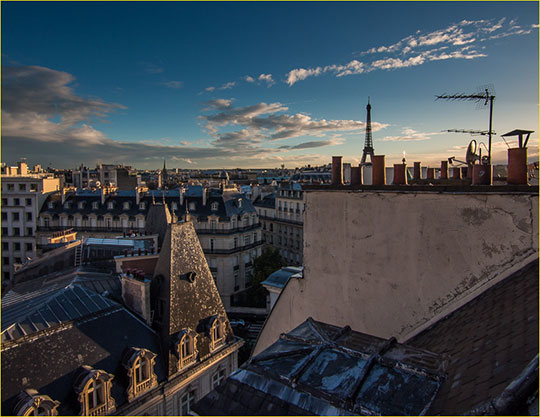
Toronto Skyline, November, 2009
Leica S2 with 180mm APO-Tele-Elmar-S @ ISO 160
___________________________________________________________________________________
Fit, Feel and Finish
I once read a review of a new Mercedes in a car magazine which described it as having been"carved from a solid block of unobtainium". That’s how the S2 feels to me.
I don’t think that I’ve ever described a camera assensuous, but with the S2 I’m tempted to. Though it’s a large camera, it feels "right" in ones hands. Every photographer that I handed the S2 had the same reaction – an instant smile.
Let’s start with the grip ergonomics. The front has a deep two finger groove and the rear a comfortable thumb groove. The shutter release falls perfectly under ones index finger. My hands are small to mid-size and it’s a perfect fit, but others who have handled it say the same, so I think that Leica got it just right. The S2 is a large camera, and not light, but it fits ones hand almost perfectly.
The eyepiece is positively huge, with great eye relief and the ability to view the entire screen with glasses on. There is a thick rubber eyecup which is surrounded by a knurled ring offering diopter adjustment.
As for controls, the S2 is as minimalist as one can imagine a digital camera being. It is the antithesis of the current trend in DSLRs with their 20–30 buttons, knobs, and wheels. Not only is this esthetically pleasing, but it’s productive as well.
LCDs
The top of the camera has a traditional shutter speed knob with discrete settings for 8 seconds to 1/4000 second. There is also a B and an A position. The knob is stiff, and unlikely to be dislodged accidentally. Next to it is a small colour OLED screen showing shooting mode, shutter speed, F stop, ISO, and shots remaining on the card(s). Being OLED it is amazingly bright and sharp – real eye candy. Unfortunately it is much less visible in direct daylight than a plain monochrome LCD would be. Visible, but onlyjust, and I for one would trade the eye candy for better readability in daylight.
The rear colour LCD itself is not the highest resolution I’ve seen, but it is quite fine, and brightness is good, even in daylight. There are four large flat buttons surrounding it. This is a design approach first taken byPhase Oneseveral years ago when they introduced their P series backs, and Leica has adopted it for the S2. Given that the two companies no longer have a business relationship it’s a testament to the solidity of the design and also to Leica’s self confidence that they emulated something that works as well as this and didn’t feel the necessity of trying something else that might not have worked as well.
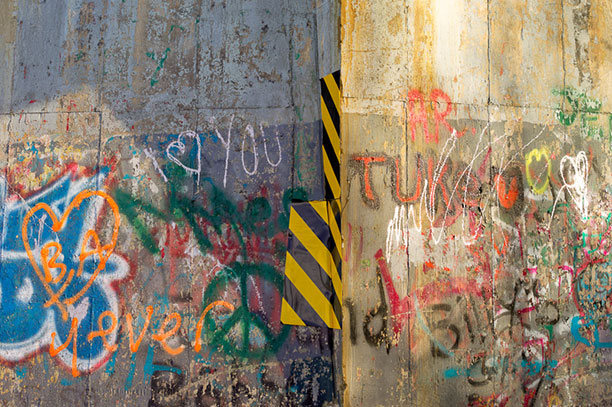
Highway Wall Art , November, 2009
Leica S2 with 70mm Summarit-S @ ISO 160
Buttons
These buttons provide access to all of the camera functions. The top left button is the master control, always providing access to a main menu. The top right is always the playback button.
There is lots of customization capability, which makes it possible to really make the camera appropriate for ones own shooting style and needs. Three of the four button can also be programmed to almost any function. So for example, I have them set to ISO, Focus Mode and Exposure Compensation. A short press takes you to their normal menu function while a long press calls up the customized command screen. Simple and effective.
Profiles
Customization also extends to creating Custom Profiles. Just about every function of the camera can be programmed into a profile, and four of them are possible. They can be given proper names, so that one doesn’t have to remember what "C3" is all about, and they can also be saved to a memory card and loaded into another camera, making instant customization of a new or loaner camera possible.
Curiously though, they are found on theImagemenu, whereas one might expect to find them on theCameraor theSetupmenu. A strange positioning decision.
Controls
The rear panel has just three other controls, a power / shutter selection switch, a scroll wheel, and a single thumb button. The power switch doubles as a selector for whether you wish to shoot with a CS lens or the camera’s focal plane shutter, and of course if the CS position is selected and a non-CS lens is mounted the camera defaults to the focal plane shutter, as it should.
The scroll wheel is for selecting a wide variety of camera settings and functions, and it also presses inwards allowing for quick selection of menu items and settings. This is a design approach apparently "borrowed" from Panasonic, and it works here exceptionally well.
The thumb button just to the right of the eye piece can be programmed to be either AF or AE lock, or set to be an AF activation button. This is my preferred way of working, as I rarely want autofocus to be activated with the shutter release. To engage this one simply places the camera on manual focus, an example of the simplicity of the Leica’s design interface.
Hot Shoe
There is, of course, a hot shoe with a Leica pin configuration to take one of the Leica branded flash units, or a Metz unit via an SCA adaptor. It also will take a studio flash trigger or other accessories.
Leica S2 with 180mm Summarit-S 70mm f/2.5 ASPH @ ISO 160
Cards
There is a card door under ones right palm. It takes two separate cards, a CF and an SD simultaneously. The camera can be set to write raws to one and JPGs to the other, or it can write raws to both cards simultaneously, creating an automatic in-the-field backup. Finally, there is also a setting to write to one card first and then to the second when the first is full.
Battery
The S2 uses a proprietary Lithium Ion battery rated at 2100 mAH. During my testing I found that it was able to produce something over 125 shots, in weather conditions ranging from about 0C to indoors, with lots of chimping. This is comparable to a P+ series Phase Back, and has the advantage of using a single battery rather than the separate ones needed with a Phase system. Hasselblad similarly has a single rechargeable battery.
UPDATE: I’m told be people that have used the S2 extensively that battery life is much better than what I have reported. My results may be because of a defective battery.
The S2’s battery system has two very clever features. The battery release latch allows the battery to drop downward, but only a few mm. It then is stopped, but a quick upward push allows it to fall free into ones hand. Nice and simple, and safe.
The second is that the small AC charger pod provided plugs directly into the battery itself. No bulky battery charger needed. It comes with interchangeable plugs for international use, and unlike the Leica X1’s charger, which I complained about here recently, the North American style plug folds inward for packing. Nice!
Tripod Mounting
It’s the little things that add up to a lot on the S2. For example, the base of the camera has both 3/8" and 1/4" tripod threads and also locator pin holes for mounting plate anti-twist security. Just another example of how Leica has really sweated many of the details on the design of the S2.
Weather Proofing
Leica makes some strong claims about the weather proofing of both the S2 cameraandits lenses. During my two weeks of testing I had neither serious rain nor snow to test it in, and didn’t feel like taking a shower with one of the few production S2s in captivity, so we’ll just have to take Leica’s word on this for the time being. Having said that, I don’t put much credence in camera maker’s claims of weather resistance. I’ve seen cameras which make such claims fail in a light mist, and others that make no such claims survive thundershowers.Caveat emptor.
Viewfinder
As mentioned, the S2’s viewfinder is very large and bright, but it is not 100%. Not even close. We discovered this when shooting tethered, and being able to see the output on a large monitor immediately after shooting. We judged that the viewfinder display is showing about 93–95% of the image captured – somewhat disappointing.
Lens Shades
On their R series cameras Leica had some of the best lens shades in the business. These are the type that are built into the lens and which slide out. Sadly, on the S2 they have adopted the much less desirable but seemingly industry standard style bayonet mount lens shade. Pity.
___________________________________________________________________________________
Lenses
The Leica S2 has a focal plane shutter but is also designed to work with leaf shutter (CS – Central Shutter) lenses. There are four lenses which will roll out initially, and each will come in two versions, one for use with the camera’s focal plane shutter and the other with a central shutter. The CS versions cost about $1,000 more than the non-CS lenses but are otherwise identical.
Summarit-S 70mm f/2.5 ASPH – $4,495
Summarit-S 70mm f/2.5 ASPH CS – $5,995
APO-Tele-Elmar-S 180mm f/3.5 – $6,495
APO-Tele-Elmar-S 180mm f/3.5 CS – $7,495
APO-Macro-Summarit-S 120mm f/2.5 – $6,495
APO-Macro-Summarit-S 120mm f/2.5 – $7,495
Summarit-S 35mm f/2.5 ASPH – $5,295
Summarit-S 35mm f/2.5 ASPH CS – $5,995
The lenses are pricey, but not especially so compared to Leica M and R glass, and also other maker’s medium format lenses.
The initial lens selection’s range of focal lengths is fine, but some photographers will find the initial lack of a very wide lens, zooms, and also something in the 300mm+ range a bit limiting.
Leica’s announced lens roadmap includes a 24mm f/2.8, 30mm f/3.5 TS, 30–90mm f/3.5 zoom, 35mm f/2.5, 100mm f/3.5, and 350mm f/3.5, though delivery dates and prices are not yet available, and I understand specs are still subject to change. All lenses are supposedly to be made available in CS versions as well as without a central shutter.
As for whether or not to purchase a regular or a CS lens, of course that will depend on ones shooting needs. Anyone working in the studio with flash and needing high sync speeds, or needing to do daylight balanced fill flash, will find the extra $1,000 for the CS lenses to be worthwhile. Others won’t. It’s a simple as that.
I’ve been informed by Leica that they anticipate shipping the S2 camera, 70mm, and 180mm lenses beginning in the second week of January, 2010. The 35mm and 120 Macro will ship "shortly afterward", but the CS series of lenses does not at this point have an initial ship date available.
I just hope that Leica gets the CS lenses into the pipeline soon because it could be very frustrating for someone who needs them to have to wait, or have to buy a non-CS lens when a leaf shutter is their eventual preference. Frankly, the CS lens delay may put a crimp in initial S2 sales, especially among fashion and wedding photographers.
Remington Frog. Toronto. November, 2009Leica S2 with 70mm Summarit-S @ ISO 160
___________________________________________________________________________________
Performance & Features
Using a 16GB Sandisk Extreme IV card the S2 is capable of shooting nine frames in six seconds, or 1.5 frames per second. This is as fast as any medium format camera yet.
Once the nine frame buffer is full it takes 20 seconds to completely clear, but if you keep your finger on the shutter release you can take one additional frame every five seconds while the buffer is writing to the card.
I’ve already mentioned the S2’s viewfinder, and in a side-by-side comparison with the Phase One 645DF, my current personal camera, I found the S2 to be somewhat bigger and brighter. Both are superior to any 35mm format DSLR, but the S2 has a slight edge over the Phase One in this regard.
I found no way to tell the camera whether settings such as exposure compensation are to be retained on power down or not. Since this is an easy firmware fix, hopefully it will be added soon.
Autofocus
The Leica S2’s autofocus is good. But I need to add the words "for a medium format camera" to that sentence for it to be comprehensive. This means that compared to even a mid-level DSLR the S2 is only competent, not comparative. But, having said that, it needs to be added that all medium format cameras are similar in this regard.
Up until last month I would have had to write that the S2 was clearly superior in terms of autofocus to the Phase One 645AF camera, but now that the new 645DF is shipping, that isn’t the case any longer. After two weeks of using both camera side by side, in the studio as well as on location, I’d judge them to be quite similar in terms of autofocus speed and accuracy. The Hasselblad H cameras are in the same league.
So,no, you’re not going to be able to reliably track a model moving down a runway, or other subject in anything except slow and consistent motion. But for what most medium format photographers use their cameras for, the S2 is on a par with the competition.
Limited Viewfinder Information and a Serious Oversight
While there is a clear indication on the rear LCD of exposure compensation settings, there is no way to set exposure compensation with ones eye to the viewfinder. Thereisa viewfinder display for exposure + / – when in Manual mode, but bizarrely, when in Aperture priority or fully automatic modes, the only way to see what amount of compensation you’re dialing in is on the rear LCD.
I find this to be a serious deficiency in the S2 for the style of shooting that I and many photographers do, and would urge Leica to address this in a firmware revision, hopefully before the S2 ships in January.
I also was disappointed to note that while ISO is visible on the top OLED, there is no ISO indication in the viewfinder either. Since on a digital camera ISO is the third exposure variable its omission in the viewfinder is another design oversight that I am very surprised at. I and other reviewers complained about this with DSLRs about five years ago, but manufacturers listened to us, and now just about all pro cameras display ISO in the viewfinder.
Shooting Modes
The Leica S2 does not have the usual selection of shooting modes on the top dial. In line with Leica’s pursuit of minimalism in this design, in addition to shutter speeds from 8 seconds to 1/4000 sec, there is an A and a B position. Not even an X for flash sync. Flash sync using the focal plane shutter is at 1/125 or less, and if you’re shooting with a flash attached at above 1/125 sec the camera will adjust itself properly automatically. B is obviously Bulb mode, for long exposures with a locking electronic cable release. I did not test the S2’s long exposure capability this time round.
There is an A position on the dial as well, and it doubles as both a full Program mode as well as Aperture Priority. To get from what is effectively Program to Aperture Priority simply press in on the thumb wheel and adjust the aperture. Another example of Leica’s minimalist design brief on this camera. For full Manual mode, simply turn the shutter dial off the A position.
___________________________________________________________________________________
Form and Function
It’s hard to know whether to call the S2 a medium format camera or not. It is styled similarly to a 35mm DSLR, but it has a much larger sensor. This sensor is in the 3:2 aspect ratio, which is the same as 35mm film and full-frame digital, rather than the 4:3 ratio of 645 medium format.
There have been cameras of this size and configuration before. The popular Pentax 67 comes to mind, as does the ill-fated and under whelming Mamiya ZD.
In the end though we’ll likely call the S2 and its successors medium format – why not?
The S2 is in fact smaller than pro series cameras like the Canon 1D series and the Nikon D3 series. Its lenses, on the other hand, are quite a bit heftier and bulkier. And, though the S2’s shutter and mirror are smooth and relatively low vibration, due to their size they are simply not in the same category with regard to vibration as a 35mm DSLR. For this reason, though it looks like a DSLR, I would think that most photographers will be shooting on a tripod or hand-held with strobes. For normal outdoor hand-held shooting I would suggest at least (1/ 2X focal length) or even 1/3X for the shutter speed, to be sure of extracting all available image quality.
___________________________________________________________________________________
Image Quality
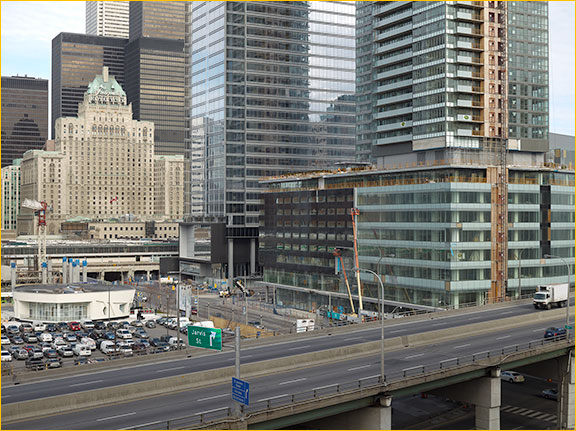
Test Sample Location
In addition to simply shooting with the S2 in a variety of situations I also did a number of carefully controlled outdoor comparison shots against the Phase One 645DF camera, 80mm Schneider lens and P40+ back. I was assisted in some of these comparison tests by Mark Segal, a well respected author and photographic educator and owner of the comparison system.
I’ll start off by cautioning that any such tests are fraught with difficulty. Light changes, focal lengths differ slightly, exposures are inconsistent, processing can be problematic, aspect ratios differ, and results are subject to subjective interpretation. There are folks on the net that also presume that they can judge from web samples what printed image look like. –They can’t!
Web images are about 100 ppi rather than a print’s 360ppi, are based on compressed JPGs, and are in a very tiny colour space – sRGB rather than a gamut wider than Adobe RGB (eg: the Epson 7900). Therefore, use what you see here as a guide, but realize that what I’m seeing on comparison prints is nothing like what you can see on your screen.
Noise
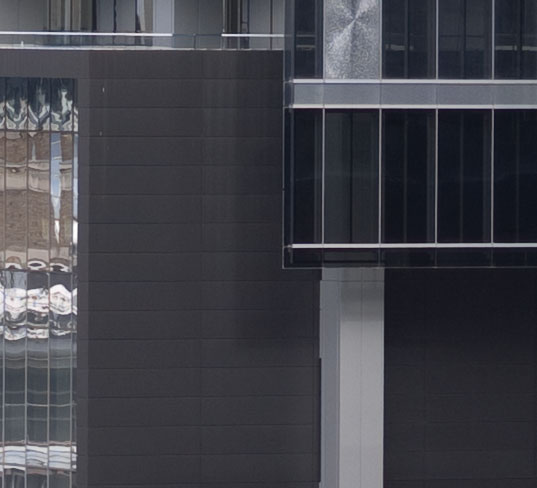
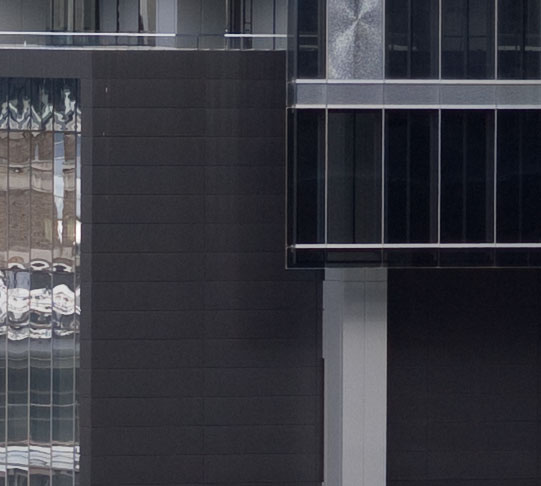

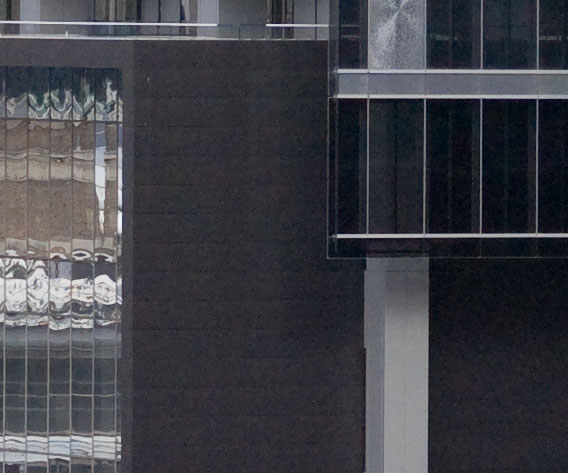
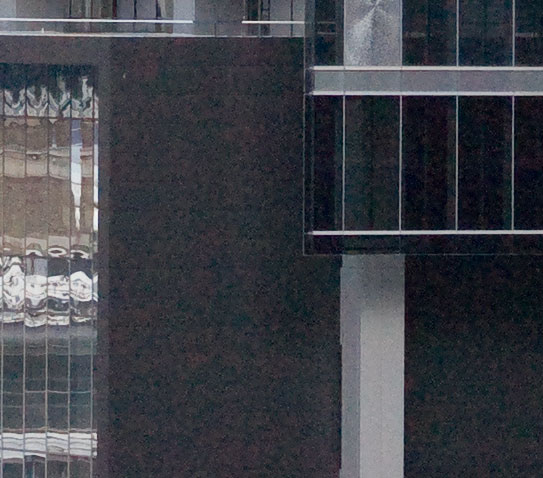
Leica cautioned me that while the S2 that I was provided with for review was a production camera, the firmware was still a work in progress, particularly with regard to high ISO noise. So please don’t necessarily regard these results as in any way indicative of what you can expect from cameras shipped two months from now, in January, 2010.
The Kodak sensor in the S2 has a native ISO of 160. ISO 80 is a "pull" sensitivity and results in reduced contrast and dynamic range. ISO 160 is, as one would expect, totally clean and free of any form of noise artifacts.
ISO 320 starts to show a bit of noise, but is completely usable even without applying any NR, and when a bit of Luminance NR is applied the images are excellent.
ISO 640 is a bit noisy, but in a pinch will satisfy. ISO 1250 isn’t terribly good, but I would disregard my sample at this point as I fully expect Leica to improve the higher ISOs before first shipments begin.
Note that because the S2’s firmware is not final I don’t feel it fair to compare it with regard to noise characteristics against a shipping product, the Phase One P40+. But, having said that, I found them comparable up to and including ISO 320/400.
Resolution
Resolution in a digital camera system is a complex amalgam of lens resolution, sensor resolution, raw processing variables and sharpening. (All digital files need sharpening, even from cameras like these without AA filters). Frankly, at this level of performance, and based on my previous experiences with this type of high-end equipment I figured that differences would be very hard to detect, and indeed that was the case.
I struggled with whether or not to show resolution comparisons here, and in the end decided not to. The main reason is that I found there to be some considerable differences between how each camera’s files were coming out of the raw processing, both with Capture One 5, and Lightroom 2.6RC, and Lightroom 3 Beta. What I discovered is that even with all sharpening turned off the S2 files appeared to be "crisper" than those from the P40+. But, when normal amounts of sharpening were applied the S2 files over-sharpened rather quickly, while the P40+ files had lots of leeway.
In the end, with very careful testing – concrete base, heavy-duty tripod, mirror lockup, self-timer, optimum aperture, multiple takes to eliminate random variables, and with input sharpening done to my personal preference, I can see no effective difference between the two systems in terms of resolving power and sharpness. They are different out of the camera, and depending on the raw converter used, but then when processed normally neither camera appears to have a resolution or sharpness advantage over the other.
The Schneider 80mm LS lens and the Leica Summarit-S 70mm seemed quite evenly matched. The Summarit seemed to have a bit of additional contrast, but this was easily equalized with a tiny bit of tweaking in LR or C1.
In the end what I discovered, and have also seen before, is that top equipment is now so good, and the variables so difficult to control with any degree of rigour, that the type of comparison tests that one can do outside of a well equipped lab are starting to become meaningless.
An interesting aside to this is that in a couple of discussions, both with the head of lens development at Leica and the Chief Technology office at Phase One, I asked the same question.Are we currently lens limited, or sensor limited?In other words, what is the weakest link?
The answer is we are sensor limited. The best current lenses are able to out resolve sensors with pixel pitches in the 6 micron range. Once we get below 5 microns (if we can do so without compromising image quality in pro-grade sensors) even the best current lenses may become the limiting factor. Note the use of the words "best lenses". While top lenses have an edge, everyday lenses are easily out-resolved by today’s sensors.
Dynamic Range
I was going to show you some dynamic range comparisons here, but in preparing the files for the web I made an interesting discovery. Whereas there was a slight though definitely visible difference in the DR between the S2 and the P40+, when the files were converted to sRGB for the web these differences disappeared. Contrast in the files increased, and the subtleties that we could see in prints simply weren’t there on screen any longer.
What we were able to see is that the P40+ has a very slight DR advantage over the S2. Maybe a third of a stop. Hardly visible, but definitely there. Just a bit more detail in the shadows when images were shot with critically matched highlight clipping.
But again, given that the S2’s firmware still is subject to a bit of tweaking, I’d call it a draw.
___________________________________________________________________________________
In The Studio and Tethered
The section below contains results from a 7-hour long studio shoot during which
we did both a still life and a model shoot and evaluations of the results.
Our video director, Chris Sanderson, recorded the day and has produced a 14 minute long
HD video of what we did and how we did it. We thought that you might enjoy seeing how sausage is made.
Click on the above photograph to view this video in a new window.
Though studio work, portraits and fashion aren’t my main thing any more, (I did a great deal of this type of work in the past) I thought it necessary to test the S2 system in this type of environment, because a great many photographers will find the S2 an appropriate camera for such shooting.
I therefore set up a model shoot with my friend Craig Samuel, one of Canada’s leading photographers and the proprietor of theS1 Group, Toronto’s busiest full service photographic rental studios & location production company. Craig has a strong interest in how the latest high-end pro equipment handles both in the studio and on location because he rents equipment as well as studios to top local and visiting photographers, and his staff and freelance camera assistants also need to be familiar with a wide range of equipment in use by demanding pros.
Our test plan (which took some 7 hours to complete), was to photograph a still life where we could evaluate resolution, noise, and dynamic range at various ISOs, and also a typical fashion model shoot. We used Profoto studio strobes with a range of heads, and worked both tethered and shooting to memory cards.
Because Phase One backs are the mainstay at Studio One, and also my personal point of comparison, we again used a Phase One P40+ back on the latest Phase One 645DF camera. This back is a close match to the S2 in terms of resolution; 40 MP at 33 mm x 44 mm, with a 4:3 aspect ratio, while the Leica S2’s sensor is 37.5MP at 30 mm x 45 mm with a 3:2 aspect ratio. Not exactly the same, but close enough, and with a similar system price.
On the Leica we shot with both the 70mm and 180mm lenses, and on the Phase system the new 80mm Schneider LS lens and the Phase One 150mm f/2.8, a pretty close match in terms of focal lengths. Leica CS lenses were not available for testing.
Leica S2 with 180mm Summarit-S 70mm f/2.5 ASPH @ ISO 160
Tethering
Let’s begin by discussing tethering. Studio photographers like to work tethered for a variety of reasons. When doing product shots or other forms of careful setups it means being able to almost instantly review the shot(s) on a large screen (usually a 30" Cinema display) and carefully evaluate composition, framing, lighting and other technical aspects of the shot.
When shooting with talent, it means that the hair stylist, makeup artist, art director, and the client (oh yes, and the photographer), can immediately review the shots and make decisions on what needs to be done. It makes the shoot a much more collaborative processes.
The Leica S2 is provided with software calledLeica Image Shuttle. This works on both Windows and Macs. The version we used is still an early beta version, but it worked fine and without any serious hiccups. We worked tethered to a high-end Mac Pro 8 core with 16GB of RAM.
The way that this tethering system is implemented is that the software allows for controlling the camera remotely, including ISO, aperture, shutter speed, shooting mode, focus – just about everything that you could wish. One sets up the software to load the files into a specific directory. Then, in Lightroom, one sets this folder to be a "Watched Folder" and the files are automatically imported into Lightroom and displayed as soon as they are transferred from the camera. It’s not quite as seamless and elegant as Capture One’s tethering, but it works just fine.
The S2 uses a USB cable to tether. It has a special 4 pin connector to the camera and a standard USB connector to the computer. There is a similar multi-pin socket on the camera under the same rubberized flap for use with an electronic release. These are coded red and green. The tethering cable is coded green, as is the USB connector, but the end of the cable is red. Also the dot on the cable for alignment is red. Do you use the green connector or the red one, marching the red plug with the red connector, or the red dot with the green connector. It’s confusing as hell until you figure it out. Given how well designed the rest of the S2 is I’m surprised at this lack of attention to cable and socket colour coding consistency. A small matter, but annoying.
The USB cable provided is a proprietary one, 5 meters long. If USB amplifiers are used it can be extended in 5 meter increments. If you think that the cable might be lost or bent or broken (as always happens to cables) you might want to ensure that a spare is on hand. You’re not going to be able to grab a replacement from a local computer dealer the way that you can with a Firewire cable.
Which brings us to Leica’s choice of USB, rather than Firewire. When shooting to a fast card the S2 is capable of 1.5 frames per second up to its six frame buffer, faster than just about any other medium format camera. But by way of reference, a P40+ Phase One back on a Hasselblad H2 or Phase One / Mamiya body can do more than 55 frames a minute to a Sandisk Extreme 4 card and there is no buffer limit – it can shoot this continuously till the card fills up or the battery dies.
When tethered via USB the S2’s performance is dramatically reduced. Each frame takes about 15 seconds to transmit to the computer and then a further five seconds till the image appears. This means that just 15 frames can be shot continuously in 60 second when tethered, and it takes a further 43 seconds to fully resolve all 15 frames.
The Phase One P40+, on the other hand, can shoot 60 frames in 60 seconds and fully resolves them in an additional 28 seconds. Indeed for the first 45 seconds the P40+ is shooting continuously at well over 1 FPS, but things slow down after about the 40th frame due to computer buffer congestion.
Simply put, the Phase One P40+ can shoot tethered or to a card four times faster than the Leica S2.
This is very disappointing performance on the part of the S2 and is attributable in part to the Leica’s choice of USB over Firewire for tethering. Since the vast majority of pro photographers use Macs, and Firewire is the de facto industry standard for tethered shooting, it’s surprising that Leica would have chosen USB.
The Still Life

We did a table-top still life with an eye toward evaluating resolution, dynamic range and noise characteristics. (Colour rendition is largely a function of camera profiling, and we didn’t want to spend time on this as it varies so widely depending on ones post processing needs).
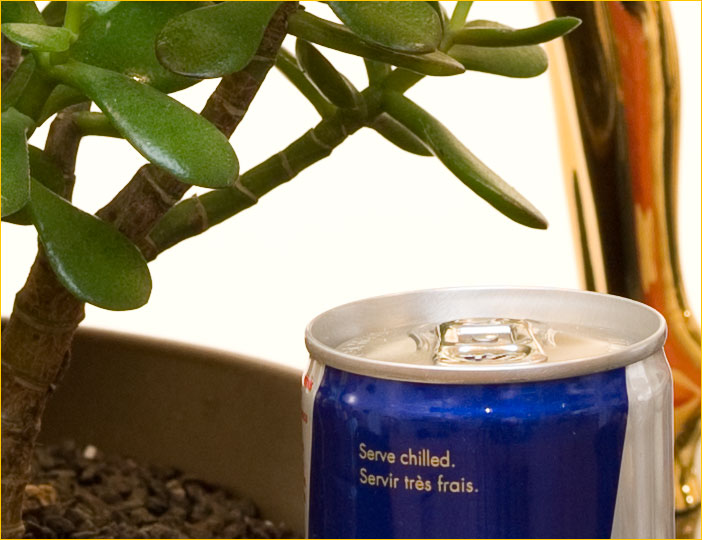
Leica S2 at 100%. Unsharpened.
Above you see the set-up and a 100% crop. We processed the files in Capture One 4.8.2, Capture One 5.0.1, Lightroom 2.6 and Lightroom 3 beta. We did so with default sharpening, and with sharpening adjusted by eye. Here’s what we found.
Choosing between the Phase One 645DF with P40+ and 80mm Schneider LS lens, and the Leica S2 with 70mm lens is a case on "nano-pixel peeping". That’s what we ended up calling it. Not "micro" pixel peeping, but "nano"pixel peeping. Yes, there were differences, but they were so small as to be inconsequential – not only barely visible on-screen at 100%, but even then subject to discussion. Image aspects examined included fringing, vignetting, blooming, moire, and other possible digital anomalies. Nothing untoward was found in either camera above the nano pixel-peeping level.
I should mention at this point that our image evaluation panel consisted of five photographers with a combined professional photographic experience of some 150 years. On most of the conclusions we were pretty unanimous. And what were these?
What we saw was that image quality from the S2 was excellent. There was nothing that could be said against it. It compared in terms of resolution, dynamic range and low noise at all tested ISOs (up to and including 640) extremely well against the Phase One system.

Leica S2, Bea Rose #1File – 100% Detail – Unsharpened
We could show you many comparison shots and other samples, but I feel that they would simply add content without increasing clarity. The message is simple. At this level of sensor, image processing, and lens quality there is precious little to choose between top contenders, at least the ones matched up here, the Leica S2 and the Phase One P40+.
Of course there are higher resolution backs from Phase One, Hasselblad, and Leaf that would outresolve these two products, but at a significantly higher price. As far as higher ISOs go, there is little to choose between then up to ISO 400–640. Since Leica has indicated that their high ISO processing is still not completed we didn’t go any higher than 640.
I’d like to thank Craig Samuel and his colleagues at theS1 Groupin Toronto for their kind assistance in conducting these studio tests. Also, Jeff Brown ofFTP Creative Imagingwho lent his experienced eyes to our evaluations and also expertly manned the wind machine during the model shoot.
Thanks as well to photographer and digital techJustin Fabianfor his invaluable assistance, and to makeup and hair stylistDiane Carreiro of Page One Agencyfor her expert assistance and patience. A word of thanks as well to Walter Borchenko ofB3K Digitalfor his technical expertise and also the loan of a Phase One P40+ back for these comparisons. And of course thanks as well to model Bea Rose.
___________________________________________________________________________________
But…
You’ll have noticed that my review started with the subtitle "Wow!, But…". There’s no doubting the S2’s build quality, handling quality, lens quality, or image quality. They are allwow. We’ve covered thewow, now to thebut.
The price, as we’ve seen, is high, but not out of line with the competition. An S2 body with 70mm f/2.5 Summarit-S lens is some $27,500. A Hasselblad H3DII-39 with 80mm f/2.8 lens is about $23,000, and a Phase One 645AF with Schneider 80mm f/2.8 LS lens and P40+ back at about $23,990. The S2 is a bit more than the competition, but in the same ballpark. (Since there is scope for negotiation when buying at this price level, prices shown here should not be taken as anything but a rough guide. The S2 will remain at list price, or close to it, until supply catches up with initial demand, but both Hasselblad and Phase One products can be had at discounts depending on the nature of the package that you and your dealer put together).
The debate over whether medium format in general is worth the significant premium over high-end DSLRs is one that each potential purchaser has to have with themselves based on their needs and the state of their bank account. It doesn’t take more than a day doing comparison shots for anyone to see the differences for themselves. The real issue is determining whether the difference is worth the price. For some it will, and for others it won’t.
The "buts" to my mind though center around the use of technical cameras and in-the-field back up. A system such as a Hasselblad or Phase One (or Contax or Mamiya for that matter) uses a removable digital back.The back can then be placed on a technical camera, such as an Alpa, Cambo, Arca Swiss, or Linhof. This allows the use of movements, as well as the spectacular medium format digital lenses made by both Rodenstock and Schneider.
Photographers doing architecture, as well as product photography and some landscape work, will find the wide range of movements available to be critical to their work, and in addition to their extreme resolution and non-retrofocus design there are some ultra-wide lenses available which can’t be matched in an SLR design.
The Leica S2, because it is an integrated camera, can not be attached to a technical view camera, and therefore isn’t usable for these applications. Whether or not this is a consideration will depend on whether the potential purchaser considers the use of a technical camera as something they need now, or might need in future.
The second "but" is the issue of in-the-field backup. Digital backs are incredibly reliable. Barring accidental mechanical damage they should last for years and many tens of thousands of exposures.(I am told that some Phase One backs used in aerial surveillance work have had over 1 million exposures without failure). But stuff happens, and whether one is doing a fashion shoot at a remote location, or a landscape project in the desert, one needs to consider the question of backup.
With a medium format system that consists of a separate back and body a camera failure can be covered with a spare body. These are not that expensive (though in the case of Hasselblad the back and body need to be sent to the factory to be matched). With a Phase or Mamiya or Contax system a second-hand body bought on e-Bay will do the job inexpensively and without hassle.
But, few photographers can afford a second digital back as fall-back in case of accident or failure. The solution that Phase One, Mamiya and Contax users have is film. Remember film? A film back and a couple of 220 Pro-Packs is enough to get through an emergency, and such backs can be had for around $100 on e-Bay, at least for Mamiya and Phase. (Note that the newPhase One 645DFbody can not take a film back. An older Mamiya or Phase back-up body will therefore be required.)
For Hasselblad users things are not quite as simple, because anything except an early H1 or H2 can not take a film back. You’ll have to purchase an H3F body at about $2,300, or find a used H1 or H2 body – but then your current digital back won’t work on it 🙁
Some people will argue that a 35mm DSLR will provide a backup, but then that means bringing another complete set of lenses, chargers, accessories, etc, which in these days of big-hassle air travel isn’t an attractive solution, at least not for me.
Which brings us back to the Leica S2. Short of a second body (another $23,000) there isn’t a simple back-up solution for location work. A DSLR system (or maybe an M9 and a few lenses) is the only alternative.
The above has been rather long-winded, but a lot of people have been asking me about the pros and cons of various systems and I’ve never had the opportunity of putting down all of these thoughts in one place at one time.
In my opinion the most practical, convenient, and inexpensive solution if location back-up is a concern is a camera / back combination that is capable of taking a film back, along with a compatible second body. This way you’re covered no matter what happens – backorbody failure.
Since the S2 will appeal to pros, if you are shooting an assignment on location then you’ll need to consider all of these factors. If you’re not traveling by air, a complete DSLR system (which you likely already own) is a perfectly viable solution. But if you’re a fine-art photographer, or a pro traveling by air where weight and bulk are major considerations, then how to satisfy your backup needs in remote locales or foreign countries is something that will need to be solved.
One final concern is with regard to sensor cleaning. On DSLRs this is rapidly becoming a thing of the past because of anti-dust sensor shake technology. On medium format backs cleaning the sensor is simplicity itself because the back comes off and the sensor is completely and conveniently exposed. A drop of fluid and a Pek Pad and the job is done.
The S2 has neither sensor vibration nor an exposed sensor, so it’s now 2005 all over again, and we need to grope around inside the mirror box with the appropriate cleaning tools and lights. Not the end of the world, but a bit of a throwback and a nuisance.

Bea Rose #2 – Tonal Interpretation
Leica S2 with 180mm Summarit-S 70mm f/2.5 ASPH @ ISO 160
___________________________________________________________________________________
The Bottom Line
As you already know from the above I’m very impressed by the Leica S2. It may well be one of the finest camera systems ever made. There is a fluidity, an elegance, and a pleasure in its use that has to be experienced to be fully appreciated. To have reached this level of sophistication on its first iteration is a testament to Leica’s efforts and talents in both lens and camera design.
I am concerned about the lack of ISO in the viewfinder, and the inability to adjust exposure compensation other than on the rear LCD. But, hopefully Leica will be able to address these in a firmware update, either prior to launch or not long afterward. Other than these it’s hard to find any fault with the S2’s handling, ergonomics or haptics.
Image quality is exceptional, and the lenses – well the lenses are so far everything that we expected them to be – in a word – superb.
The price is of course high, but then it’s a Leica. You knew that, right?
For photographers working tethered in the studio or on location the slowness of the S2’s USB tethering may be an issue, but otherwise when shooting to a card for most photographers the S2 has little to criticize in terms of shooting speed other than the limited buffer, which I hope is eventually expanded.
The field backup situation is, as discussed, something that will be more of a problem for those who work on location and who travel by air, rather than those that can throw a DSLR kit in the trunk of their car as backup.
If you can afford an S2, and need or desire what it has to offer, then there’s no question in my mind that it will be a hugely satisfying purchase. It isn’t the perfect solution for some, especially for those that need to use technical cameras and who have field back-up concerns, but otherwise it has my unreserved recommendation.
___________________________________________________________________________________
UPDATE – April, 2010, by Nick Rains
I have been working with the Leica S2 for the past ten days or so and fully concur with Michaels opinions on this fine camera.
The lens quality is exemplary, the camera build is superb as you’d expect from a Leica, and the overall package is very attractive indeed. I was very surprised just how easy this camera is to use, it fits the hand nicely, controls are quite intuitive and it somehow encourages you to go out and shoot some images. Like many beautifully made things, there is a joy in the using of it and a confidence that it will perform up to your expectations.
I’m also very impressed with the 16-bit files. There is a lot of headroom for pulling out shadow detail without the shadow tones breaking up to noise. You find yourself using much higher values of ‘fill light’ than usual and this gives a wonderful tonal smoothness to the images that is typical of that old Leica low contrast look.
I must say that whilst I am sure the Phase and Hasselblad backs are capable of equally fine results, I do not enjoy the cameras themselves – namely the H3/H4 and the Phase DF. Both are quite clunky with severe mirror slap, modest autofocus and, to my way of thinking, poor ergonomics. They obviously derive from classic medium format camera body form-factors – cameras that were functional but not that much fun to use. The Leica, with its 35mm camera style (like the wonderful Pentax 67) is far more pleasant to use and this has to count for a lot. The AF is swift and precise, and the shutter release, whilst showing a bit of delay, is so smooth that even the hushed sound of the mechanism operating is very cool!
But that’s just my opinion – the main reason for this update is that just as I posteda blogentry about my experiences I found out that a new firmware version had been released which addresses many of the ergonomic concerns that Michael, and I, had about the camera.
So, from today:
The exposure compensation will be displayed in the viewfinder.
The DOF button can be programmed to a custom function.
There is an HMI lighting WB Preset added.
Plus some other subtle but welcome changes.
No ISO display in the finder though – maybe in the future.
Anyway, the Exposure Compensation was a big issue – it interrupted the camera’s slick operation which was a shame because it is so smooth to use, and having to pull back, press a button for 1.5 secs, dial in the compensation and click the dial to confirm was just too clumsy. Furthermore, there was no way to tell it had been set so you could forget to reset it to zero.
So now it’s fixed. Well done Leica.
You can get the download here:https://owners.leica-camera.com/en/login
___________________________________________________________________________________
November, 2009

